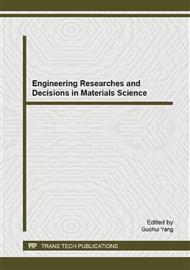[1]
Gebauer, J., Skalny, J.: Specialty cements for concrete exposed to chemical attack, Proceeding Non-Traditional Cement Concrete Symposium, June 11-13 2002, Brno, Czech Republic, ISBN 80-214-2130-4, pp.7-17.
Google Scholar
[2]
Shi, C., Krivenko, P.V., Roy, D.: Alkali-Activated Cements and Concretes, Taylor &Francis, 2006, ISBN10: 0-415-70004-3.
DOI: 10.4324/9780203390672
Google Scholar
[3]
Provis, J. L., van Deventer, J. S. J.: Alkali Activated Materials, RILEM State-of-Art Reports, TC 224-AAM, Springer, 2014, ISBN 978-94-007-7671-5.
DOI: 10.1007/978-94-007-7672-2
Google Scholar
[4]
Bilek, V., Rovnanik, P.: Resistance of alkali activated slag concretes to freezing and thawing in different solutions, in V.M. Malhotra (Eds) Proceedings of 8th CANMET/ACI Conference on Recent Advances in Concrete Technology, Montreal, 2006, Supplementary papers, pp.1-14.
DOI: 10.14359/6086
Google Scholar
[5]
Bilek, V., Szklorzova, H.: Freezing and thawing resistance of alkali-activated concretes for the production of building elements, in V.M. Malhotra (Eds) Proceedings of 10th CANMET/ACI Conference on Recent Advances in Concrete Technology, Sevilla, 2009, Supplementary papers, pp.661-670.
Google Scholar
[6]
Kaufmann, J.: Experimental identification of damage mechanisms in cementitious porous materials on phase transition of pore solution under frost deicing salt attack, EMPA Report No. 248, EMPA, (2000).
Google Scholar
[7]
Bilek, V., Tomalova, V., Topolar, L., Pazdera, L., Zidek, L.: Searching for environmentally friendly alkali activated concrete for building elements, 10th CCC Congress, Liberec (Czech Republic), 2014, in print.
Google Scholar
[8]
Shi, C., Stegemann, J.A.: Acid corrosion resistance of different cementing materials, Cem. Concr. Res., 30 (6), 2000, pp.803-808.
DOI: 10.1016/s0008-8846(00)00234-9
Google Scholar


